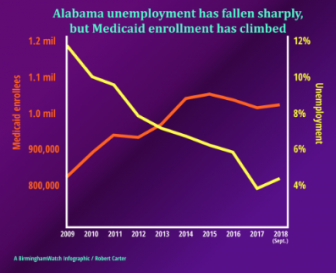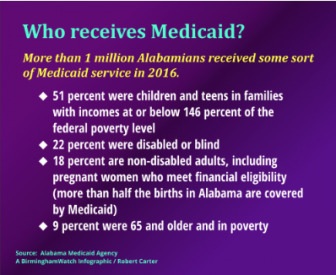As Alabama’s Unemployment Rate Decreases, Medicaid Enrollment Does Not

By Mary Sell
Alabama’s unemployment rate hit record lows in the past year, falling below 4 percent, but the number of people enrolled in Medicaid hasn’t decreased.
Medicaid, the health care provider for the state’s poor and disabled, has higher enrollment now than when the unemployment rate hit nearly 12 percent in 2009. September enrollment was up slightly this year compared to September 2017.
While more people are working, not all of them are in jobs that pay enough to get their families off Medicaid, advocates say.
Medicaid’s enrollment is troubling to state lawmakers, who’ve been advised that the way to curtail Medicaid’s ever-expanding cost is to get more Alabamians employed.
“It’s a large concern, why the rolls aren’t shrinking as people get into the workforce,” state Sen. Arthur Orr, R-Decatur, said recently. “I remember being told that as unemployment falls, so would Medicaid enrollment.”
Orr’s a member of the Senate General Fund budget committee that each year allocates more state dollars for Medicaid — $755 million this budget year. He’s also advocated for work requirements on the about 75,000 able-bodied adults who receive Medicaid because of their low incomes and because they’re caretakers to children and others who qualify.
Childless, able-bodied adults don’t qualify for Medicaid. Meanwhile, children make up the largest group of Medicaid enrollees.
Employed, but Still Qualifying for Medicaid
There are multiple reasons the number of enrollees hasn’t decreased in the past year, a spokeswoman for the agency said.
“As a bare-bones program with very limited eligibility, Alabama Medicaid’s enrollment changes may be more subtle or delayed than in other states with more generous programs,” Robin Rawls said recently in an email.
Possible factors include:
- Some newly employed people may continue on transitional Medicaid for a year, depending on their circumstances.
- Some newly employed may be able to obtain health insurance but, depending on their income, their children may continue to qualify for Medicaid. Pregnant women may also continue to qualify, if they meet income limits.
- Some newly employed may not have access to family health coverage, so their children may continue on Medicaid if they qualify.
- A newly employed parent or guardian may not have been covered by Medicaid previously, so there is no change in Medicaid numbers after they get a job.
Orr said that, even with the transitional period from Medicaid to private insurance, he would expect enrollment to shrink.
“You would think, even with that lag, we should start to see the Medicaid rolls going down as people get employed,” he said.
The Alabama Department of Labor recently reported that 40,377 more Alabamians were working in October of this year than in October 2017.
Dr. Don Williamson was the public face of Medicaid for several years, until he left in 2015 to lead the Alabama Hospital Association.
Last week, he said he previously had told lawmakers that increased employment would decrease the number of people on Medicaid.
“That is absolutely true,” he said. “But here’s the problem. In order to get them off Medicaid, you have to get them jobs that pay high enough wages that they’re no longer Medicaid eligible, or provide them a job that allows them to get insurance in the private sector.”
In 2015, 36 percent of children on Medicaid had at least one working caregiver. Children and pregnant women qualify for Medicaid if their household income is up to 146 percent of the federal poverty level. For a family of four, that’s an income of $36,646 or less. A family of two qualifies if the household income is $24,036 or less. At $7.25 an hour, a full-time, minimum-wage job pays $15,080 a year.
“I suspect the bulk of Alabama’s employment growth has occurred in low-wage jobs, which wouldn’t reduce children’s Medicaid eligibility,” said Jim Carnes, policy director at the advocacy group Alabama Arise. “If Alabama lawmakers really want to lift children out of Medicaid eligibility, they should take steps to lift household earnings.”
Not the Only State
Like Orr, state Rep. Lynn Greer expected Medicaid enrollment to drop along with unemployment.
“We all thought that, but that’s not working out,” Greer, R-Rogersville says. He’s on the House General Fund budget committee. “That was the intent, you put people to work and they can provide for themselves. But apparently that’s not how it’s working. And I don’t think we’re the only state.”
The Kaiser Family Foundation recently reported that, for the first time in a decade, states in 2018 didn’t report overall growth in Medicaid enrollment. There was an average decline of .6 percent.
According to Kaiser, states largely attributed the enrollment slowdown to a strengthening economy. Some states also cited efforts and systems to verify enrollees’ continued eligibility for Medicaid as a factor.
Alabama’s Medicaid enrollment peaked in 2015 at about 1.05 million. Some rule changes related to the Affordable Care Act and people’s increased awareness that they qualified for the program were factors.
Medicaid Budget
Alabama Medicaid will receive $755 million this fiscal year from the state’s General Fund budget. The agency also receives other state and federal money and provider fees. In 2018, its total appropriation was $7.3 billion.
Able-Bodied Adults
Earlier this year, Gov. Kay Ivey began the process of asking the federal government to allow Alabama to impose a work requirement on able-bodied adults’ access to Medicaid. Alabama is one of several states taking such steps.
About 75,000 able-bodied Alabamians with incomes of just a few hundred dollars a month receive Medicaid, the agency said earlier this year. Most of the recipients are caregivers to young children or others who receive health care through Medicaid because their family income is at or below 18 percent of the federal poverty level. For a family of four it’s $377 a month or less.
The number of able-bodied adults on Medicaid in Alabama has more than doubled in the past five years, according to the agency.
In its waiver request to the federal Centers for Medicare and Medicaid Services, the Alabama agency said it will assist able-bodied recipients to “improve their health outcomes and improve their economic stability, which will assist the state in having healthier citizens.” It also said the change would make Medicaid more sustainable.
The request was resubmitted this fall and is still pending.
Opponents say the proposal puts poor adults in a Catch-22, forced into jobs that pay enough to disqualify them for Medicaid but not enough for them to purchase health care coverage.
In response, Medicaid extended its transitional coverage to 18 months.
The proposed work requirements mirror those of the federal Temporary Assistance for Needy Families program. It requires that individuals participate in 35 hours a week of employment-related activities, except for parents and caretaker relatives with a child under age 6 years, who must participate in 20 hours per week.
Employment, on-the-job training, job searches, high school, GED or higher education classes, community services and technical training all count toward the proposed requirement.
The proposal also includes a list of possible reasons one could be exempt from the requirement, including medical conditions or age, receiving treatment for drug or alcohol addiction, being a single parent of a child 12 months or younger or being a single parent of a child 6 or younger for whom childcare is not available.
It’s unclear how many people may be exempt.
Orr, the state senator, is a proponent of the work requirement.
“The main goal is to get the individual up and out and functioning to the point where they won’t need to rely on Medicaid over time because they got their addiction whipped, got a job, etcetera,” Orr said. “Many people in the workforce currently pay large percentages of their paycheck for health care, so why should we reward able-bodied individuals with free health care but not require anything from them to begin the pathway to self dependence?”
Even if Alabama gets federal approval on its request, Orr said he’ll sponsor legislation next year to make the work requirement law.
What the Centers for Medicare and Medicaid Services gives in President Donald Trump’s administration, it could take away in another administration, Orr said.
Mass trial shines a light on rape culture in France
A harrowing and unprecedented trial in France is exposing how pornography, chatrooms and men’s disdain for or hazy understanding of consent is fueling rape culture.
What’s your favorite thing about fall?
With cooler mornings and shorter days, if feels like fall is finally here. So what’s your favorite thing about fall? We put that question to people at our recent News and Brews community pop-up in Cullman.
Teammates LeBron and Bronny James make history as the NBA’s first father-son duo
The Jameses, who both play for the L.A. Lakers, shared the court for several minutes on the NBA's opening night. They join a very small club of father-son teammates in American professional sports.
After John le Carré’s death, his son had the ‘daunting’ task to revive George Smiley
Nick Harkaway grew up hearing his dad read drafts of his George Smiley novels. He picks up le Carré's beloved spymaster character in the new novel, Karla's Choice.
When Steamboat goes WHOOSH, scientists look for answers
What triggers geysers to go off is still not well understood. A new paper shows that one small earthquake likely triggered an eruption of the world's tallest active geyser, Steamboat.
Trump’s ex-chief of staff warns his former boss would rule like a ‘fascist’
John Kelly is one of several Trump-era White House officials to publicly criticize their former boss, arguing that Trump is not fit to hold office again.






